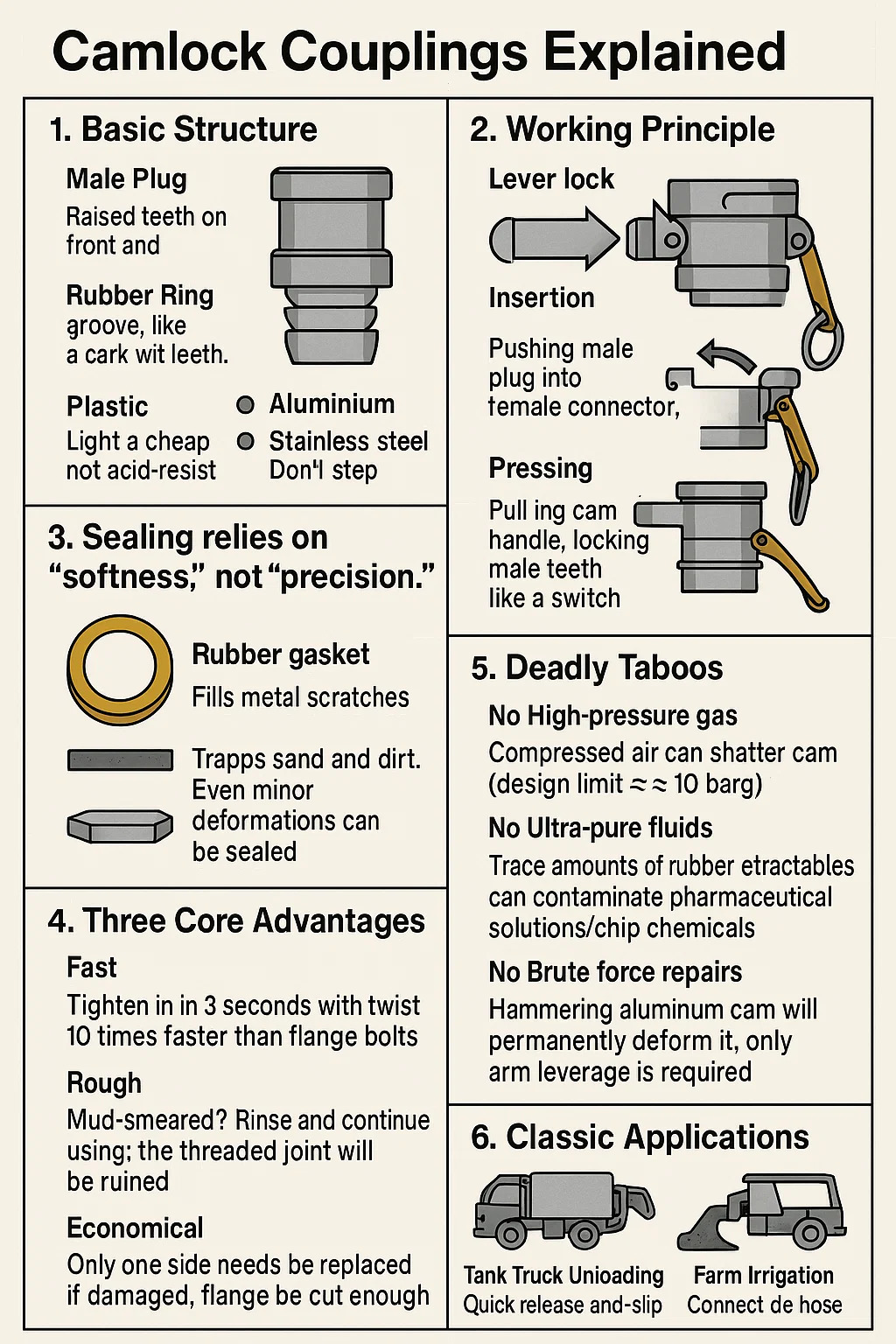Camlock Couplings Explained
1. Basic Structure: A simple, crude mechanical lock
Male Plug: Raised teeth on the front and a rubber ring groove, like a cork with teeth.
Female Socket: L-shaped slots on the inner wall and a cam handle, like a trap.
Material:
Aluminum: Light and cheap, not acid-resistant.
Stainless steel: Corrosion-resistant, but expensive.
Plastic: Suitable for chemicals, don't step on it.
2. Working Principle: Lever lock
Insertion: Push the male plug into the female connector, and the teeth slide into the L-slot (even if it's crooked, a kick will do).
Pressing: Pull the cam handle, locking the male teeth like a switch.
Tightening: The cam locks itself when vibrating, so it won't loosen even after a truck shakes all night.
3. Sealing relies on "softness," not "precision."
Rubber gasket:
Fills metal scratches.
Traps sand and dirt. Even minor deformations can be sealed.
No matter how rough the metal surface: Deep lathe cuts? No problem; the rubber is soft enough to seal.
4. Three Core Advantages
Fast: Tighten in 3 seconds with a twist of the handle, 10 times faster than flange bolts.
Rough: Mud-smeared? Rinse and continue using; the threaded joint will be ruined.
Economical: Only one side needs to be replaced if damaged; the flange needs to be cut and re-welded.
5. Deadly Taboos
No High-Pressure Gas: Compressed air can shatter the cam (design limit ≈ 10 barg).
No Ultra-Pure Fluids: Trace amounts of rubber extractables can contaminate pharmaceutical solutions/chip chemicals.
No Brute Force Repairs: Hammering the aluminum cam will permanently deform it; only arm leverage is required.
6. Classic Applications
Tank Truck Unloading: Quick release and anti-slip, a driver's favorite.
Farm Irrigation: Mud-smeared? Connect the hose and flush.
Chemical Plant Discharge: Acid leak? Replace with a fluororubber gasket.
| Aspect | Description |
| What it is | A quick-connect coupling system using a cam lever mechanism for instant locking/unlocking of fluid connections. |
| Main Components | - Male Plug: Has lugs (teeth) and groove for gasket- Female Socket: Contains cam levers and L-slots |
| How it Works | 1. Plug inserts into socket2. Cam lever rotates to lock behind plug lugs3. Gasket compresses to seal |
| Key Benefit | Faster than threaded/flange connections - connects/disconnects in seconds with no tools |
| Materials | - Aluminum (lightweight, general use)- Stainless (corrosion-resistant)- Plastic (chemical resistance) |
| Sealing Method | Compression of rubber gasket (NBR, FKM, etc.) against metal surfaces |
| Pressure Limit | Typically ≤10 bar (NOT for compressed gases) |
| Common Uses | - Tanker truck loading/unloading- Agricultural irrigation- Industrial fluid transfer |
| Don't Use For | - High-pressure systems- Compressed gases- Ultra-pure fluids (pharma/semiconductor) |
| Why Choose It | - Extreme durability- Works when dirty- Easy field repairs- Universal compatibility |


 英语
英语 俄语
俄语












